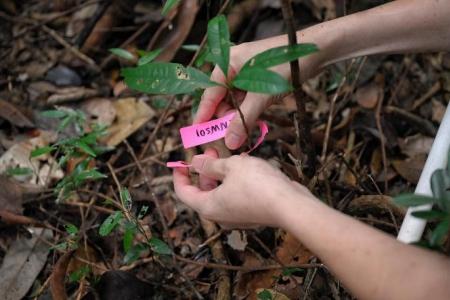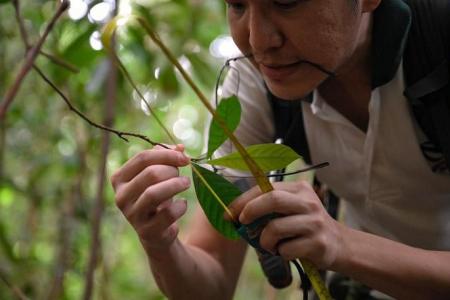In a bid to coax the return of primary forest trees
A national effort to monitor the pulse of Singapore’s green heart is under way, with researchers studying various aspects of forest health in a network of 60 plots that criss-cross the Central Catchment Nature Reserve.
Each 20m-by-20m plot is a mosaic of the plants and animals that thrive in the different forest types – from young to mature forests – in Singapore’s largest nature reserve.
They are part of a long-term forest ecological monitoring plot network, a research initiative launched by the National Parks Board (NParks) in May 2022 to keep track of the forests’ vital signs, and contribute to efforts to protect and restore the country’s remaining rainforests.
Under the initiative, NParks researchers conduct routine surveys of the 60 plots – tagging seedlings, measuring trees, and monitoring the presence of wildlife through physical surveys and with the help of technology such as camera traps and acoustic sensors.
Now that the surveys are entering their third year, the painstaking work of measuring, monitoring and identifying wildlife is paying off, with the data from the network providing forest ecologists with a treasure trove of information.
Researchers from eight ongoing projects either use the plots as study sites, or use vegetation data from the past and ongoing surveys of these plots, said Dr Chong Kwek Yan, a senior researcher at the research and conservation branch at NParks’ Singapore Botanic Gardens.
These projects cover a wide range of topics, he added, from the mapping of forest carbon stock in Singapore to understanding the impacts of climate change on forest trees and plant-animal interactions.
All of these will provide insights into how the botanical, zoological and microbial worlds intertwine in the forest, helping researchers tease out trends and glean insights into what makes Singapore’s forests tick.
“We know so little about so many of our tree species,” Dr Chong said.
“When do they flower and fruit? Is flowering triggered by dry spells or rainy weather? What animals disperse their seeds?”
Unlike in temperate regions, where spring marks the season of growth, the cues that trigger tropical forest renewal – such as flowering and fruiting – are discordant, with no sharp changes in temperature or rainfall that serve as obvious signals for the start of rejuvenation.
As the studies of wildlife, vegetation and soil progress at these plots, they provide a snapshot of the forest community.
In time, these will tell the story of a regenerating forest and yield valuable information – such as flowering and fruiting trends, seedling growth rates, the presence of wildlife and seed dispersal patterns – to help researchers on a mission to realise Singapore’s City in Nature aspirations.
Bringing back Singapore’s green jewels
One of these 60 plots is located just 1km away from the nearest carpark, but the vegetation was so dense that it took researchers almost an hour to get to the site.
The Straits Times is not revealing the location of the plots as these areas are not accessible to the public.
Armed with a Global Positioning System (GPS) tracker, a couple of plastic poles and a set of telescopic pruners, Dr Chong and his colleague, researcher Lim Yi He, as well as wildlife ecologist Fung Tze Kwan from the National University of Singapore, navigated their way through fallen logs, wild boar wallows and spiky rattans.
Their mission: Collect some leaf samples for genetic analysis back in the laboratory, and tag all tree seedlings above 20cm in height within four 1m-by-1m quadrants.
The four seedling quadrants are located in a plot that is a study site being used by Ms Fung for her doctoral research on seed dispersal by fruit-eating animals and their role in forest recovery.
“With Kwek Yan and Yi He’s help in identifying the different species of seedlings within the plot, I can examine how these plants might have arrived here, such as if they were dispersed by birds or mammals, as well as the characteristics of their fruits and seeds for dispersal, based on scientific literature and field data,” said Ms Fung.
Other information collected by NParks from the site – such as the composition of mature trees and camera trap footage – would also come in useful, she added.
“For example, if we record seedling species typically dispersed by birds within the plot, and there are no adult trees of the same species nearby, we know that these seedlings sprouted from seeds that were likely brought in by birds,” she said.
“The wildlife surveys conducted in the same plot can provide us with an understanding of what frugivorous (fruit-eating) animal species have been visiting this area.”
Today, most of Singapore’s forests are secondary forests.
“About 70 to 80 per cent of trees in such forests are dispersed by animals”, said Dr Chong.
“So research like Tze Kwan’s is important in understanding how our forests are regenerating.”
On the shoulders of giants
Two poles mark the centre of the plot, but only one of them bore an inscription: “NRS May 1993”.
It is a reference to the nature reserves survey of the early 1990s, when the plots were established by Mr Wong Yew Kwan, Singapore’s first commissioner of parks and recreation.
That survey was commissioned soon after NParks was founded in 1990 to provide a comprehensive inventory of the trees in the Central Catchment Nature Reserve, but they were not comprehensively re-surveyed after that time.
These “Wong Yew Kwan” plots were rediscovered by NParks staff in 2008 with the help of old maps and markers left at the sites.
The GPS coordinates of the sites were then logged so they could be easily located in future.
With the launch of the long-term forest ecological monitoring plot network in 2022, a comprehensive re-survey of the trees in the plots is under way, building on the work by Singapore’s pioneer foresters.
The information obtained from the early surveys of the plots influenced Singapore’s nature reserve management policy over the next three decades.
For example, the survey in the 1990s had divided Singapore’s forests into four types, ranging from relatively open unforested areas where trees are sparse, all the way to primary forest plots marked by dense vegetation, a closed canopy and the presence of dipterocarp trees.
This family of trees are the sentinels of South-east Asia’s forests, growing straight and tall and making up over 50 per cent of the region’s lowland forest canopy.
Today, the presence of these slow-growing, long-lived trees indicates a primary forest patch.
Dr Chong said the early classification system has informed NParks’ species recovery and reforestation efforts, with researchers surveying primary forest patches more extensively in search of rare species, for example.
“Forests are dynamic, they are changing all the time.
“Plots that started out as young secondary forests have moved on to become more species-rich,” he said.
But the earlier surveys had also shown that Singapore’s forests faced an “arrested succession” – researchers could not find dipterocarps even in mature forest plots that had regenerated for over a hundred years.
Can the information and insights collected from this network of forest plots help coax the return of the dipterocarps?
“That is the dream,” said Dr Chong.
“Healthy secondary forests can help encourage dipterocarp recruitment.”
The Wong Yew Kwan plots serve as research infrastructure that will help consolidate knowledge of Singapore’s forests from the various research projects, and help us understand forest succession better, he added.
“But in the meantime, improving the forest cover in Singapore would also be nice.”
Get The New Paper on your phone with the free TNP app. Download from the Apple App Store or Google Play Store now



